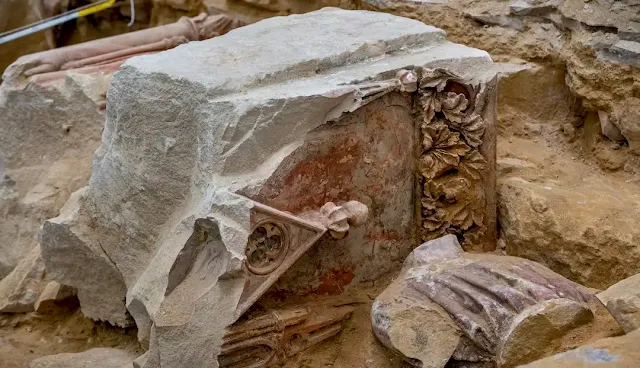The fire that nearly burned down Notre Dame Cathedral in Paris in April 2019 opened up an amazing view of a unique slice of history. Archaeologists seized a rare opportunity in the extensive restoration work that lasted for five years to dig underneath the iconic structure; it turned up more than 1,000 fragments of historical artworks hidden from public view.
 |
| (Photo Credit: Denis Gliksman/National Institute for Preventative Archaeological Research) 1,000 Ancient Treasures Found Beneath The Ashes |
Read More: World's First Tilted LED Planetarium To Open In Mysuru By 2025
This unique discovery happened thanks to a French law called "preventative archaeology." This law lets experts study important archaeological remains that could be destroyed by construction work. Beginning in February 2022, this excavation unearthed treasures spanning the ages of the cathedral. Reportedly, these discoveries are currently housed in Paris's Musée de Cluny, which would provide a space for mediæval artwork.
The stone relics constituted some thirty fragments from the rood screen at Notre Dame, which divided the choir nave from the nave back in the 13th century. Among these sculptures was.a bust of Christ and a finely carved image of a man wearing a tunic, both of them believed to be lost history.
Well, being the director of the museum, Séverine Lepape was over the moon about this; the figures are considered to have been sculpted almost in 1230. The fragments of these statues reflect some ideas on how this work would have looked in its prime; some fragments still reveal portions of their exuberant ornamentations. Traces of polychromy show what a medieval visitor would have seen before the colors disappeared over time according to Damien Berné, curator of the exhibition 'Making Stones Speak. Notre Dame's Mediaeval Sculptures.
The discoveries stretch well beyond the Middle Ages, uncovering a history of some 2,000 years. Archaeologists found Carolingian buildings dating from 750 to 887, houses from Roman times, and various signs of handicraft. Such signs would give us more of an insider's view of life on Île de la Cité long before the church was erected.
For the first time, the cathedrals' foundations were excavated. What further substantiates the importance of these finds is that, according to Christophe Besnier of the French National Institute for Preventative Archaeological Research (INRAP), the finds are now providing points of reference from nearly all historical periods since the first century. "This site, we can now piece together more than 2,000 years of history," he said.
The renovation of Notre Dame adds an aspect of history to France while allowing the experts to bring out the finds, so much as it shed new light into the past of a site with a complex history.



.jpg)

%20(1).jpg)

0 Comments
Do Share Your Views